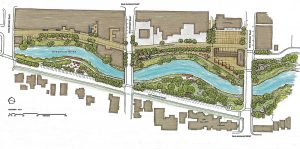Owen Sound is poised to make waterfront enjoyment an even biggerpart of its charm.
Owen Sound’s history is intricately tied to its harbour, and the city once known as “Little Liverpool” is gearing up to ensure the waterfront creates an even more important link to its future.
Originally named Sydenham, Owen Sound was a “jumping off point” for travellers and immigrants as well as a major port of call for the merchant ships plying Georgian Bay from the 1800s onwards, earning it a rowdy reputation in the late 19th and early 20th centuries. Today the harbour that once brought sailors ashore for the brothels, bars and bootlegging has evolved into a local attraction that is as peaceful as it is picturesque.
Large ships continue to frequent Owen Sound regularly, moving grain and other goods in and out or docking for repairs, but the city’s harbour and the adjoining Sydenham River, which runs through its downtown, have taken on new significance as part of an urban planning strategy that incorporates waterside walking, cycling, arts and cultural elements and on-the-water activities as incentives to fuel growth, economic development and tourism.
“The waterfront is a huge asset for the city; it really is invaluable,” says community services director Pam Coulter. “When you come here and you experience that waterfront, it’s such a great place that you definitely want to come back, and if you work here you think, ‘wow, I am so lucky to be able come down here on my lunch and take this beautiful walk.’”
Owen Sound’s harbour already offers plenty to see, do and experience, including Kelso Beach; a marina; municipal boat launch; pedestrian walkways lined with benches, flower planters and heritage lights; a historic CP train station (soon to be transformed into a local craft brewpub); and The Community Waterfront Heritage Centre and Marine Rail Museum, housed in a former CN Railway station together with the city’s Tourism Centre.
The Waterfront Trail system follows the shoreline, connecting to the west with the Georgian Bluffs Rail Trail and to the east with the Tom Thomson Trail, which runs all the way to Meaford and the Georgian Trail. The section of trail on the city’s east waterfront was recently upgraded and extended from the Bayshore Community Centre along the waterfront, and the rail trail has been widened and hard surfaced.
Now, the focus for upgrades is shifting from the harbourfront to the Sydenham River, which the city considers an extension of the waterfront that connects Georgian Bay with the downtown.
“We’ve done a lot of work on our main street and the downtown, but the next phase we’ll be turning our attention to is what we like to call the Downtown River precinct,” says
Coulter. “It really is to turn our attention back to the river to make it an inviting, inclusive, beautiful urban space with all kinds of activities and reasons to bring more people to the downtown.”
The Downtown River Precinct will comprise a continuous riverside trail linking the harbour to the Mill Dam. Along the wide, landscaped promenade will be benches and tables, parks and parkettes, a multi-purpose civic square for special events and outdoor markets, landings for short-term boat tie-up and canoe/kayak launching, space for art and artisans as well as cultural elements. “The focus is on taking back some of that river space for pedestrians and making it a comfortable space; an urban park,” says Coulter. “We want to connect pedestrians better between the downtown and the waterfront.”
Pedestrians currently have to cross the four-lane-wide 10th Street to get from the harbour to downtown, so that impediment is also being addressed. “Engineers are now doing environmental assessment on the 10th Street bridge,” says Coulter, “and one of the questions that is being asked is, how do we connect pedestrians better with the downtown? It’s easier if you’re in a kayak to get from the river to the harbour, so we want to make it easier for pedestrians, too.” Options could include a pedestrian overpass or tunnel.
Work is set to begin in early 2018 on the first phase of the Downtown River Precinct project, with one phase per year expected to be completed over the next four years.
In the meantime, in addition to its long-running Summerfolk music festival August 18-20, Owen Sound is gearing up for another major shindig on the waterfront this summer. From June 30 to July 9, the city will celebrate Canada’s 150th and Owen Sound’s 160th birthdays with the “big, bold, innovative” Maawanji’iding: Festival Canadiana. The First Nations and Métis communities will join the city and other community partners to present a series of entertaining and inspirational events for all ages, most of which will be free to the public or offered at nominal charge. “We’re going to be celebrating our first nations heritage along with Canada’s first nations heritage and the sesquicentennial,” says Coulter.
The goal with all of the waterfront improvements and urban design is to put Owen Sound firmly on the map for tourists, visitors, new residents and businesses.
“The waterfront really is what makes Owen Sound unique in terms of where people want to live and spend time,” says Coulter. “We see it as a valuable asset to build on for the future.” ❧












